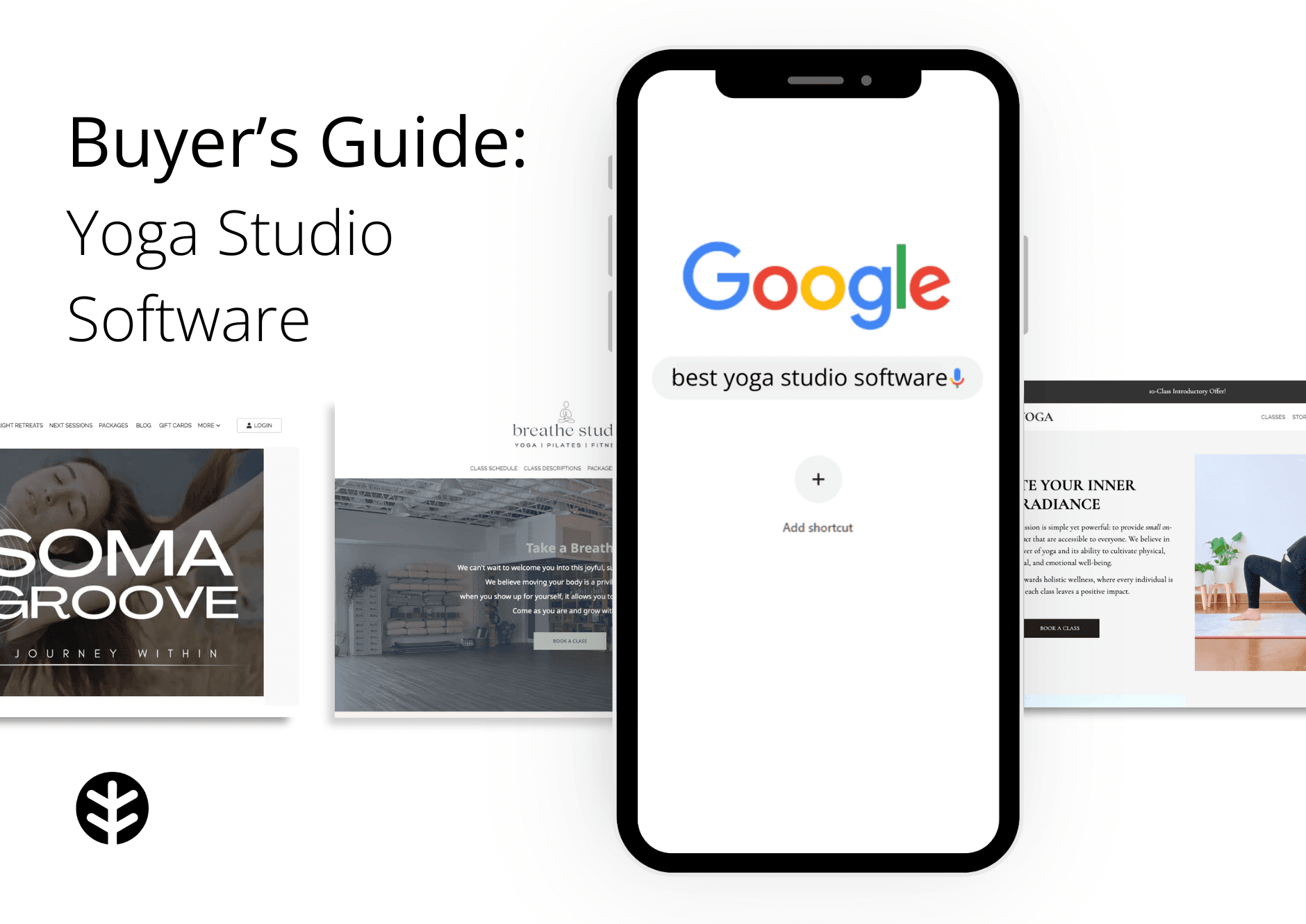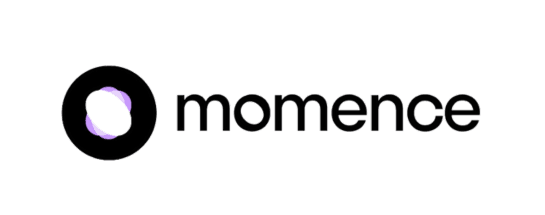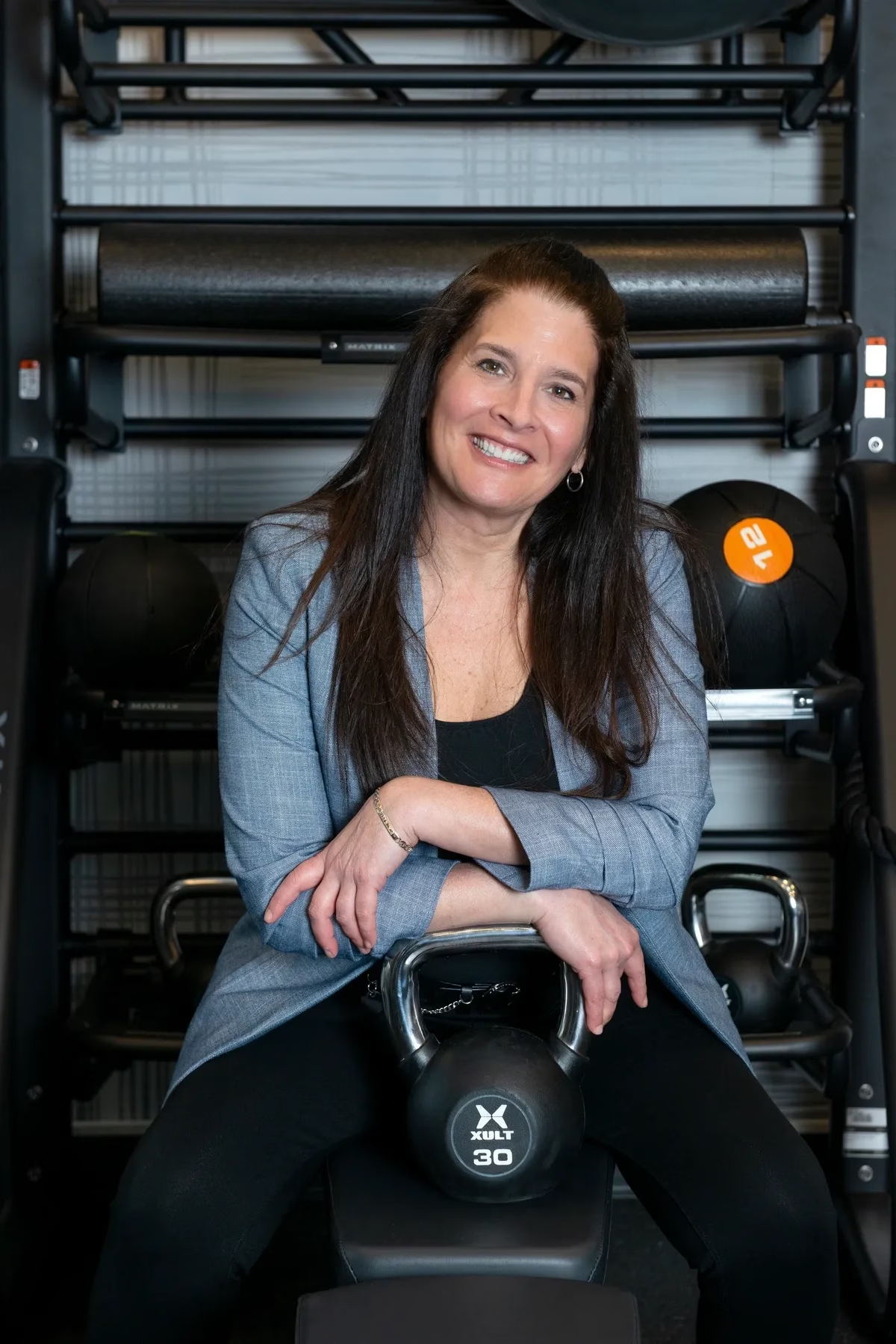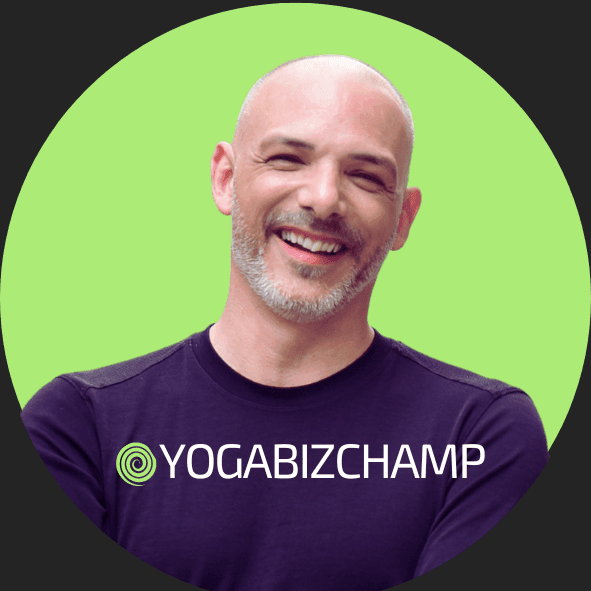Yoga Studio Software Buyer’s Guide 2025
Compare Features, Benefits, and Pricing
This buyer’s guide is designed to help you navigate the various software solutions on the market, highlighting key features, user reviews, and pricing to aid in your decision-making process.
The goal is to provide an expert-informed, unbiased resource* that empowers you to make an informed choice, ensuring your business thrives with the proper technological support.
Table of Contents:
- Introduction to Yoga Studio Software
- Compare Top Yoga Studio Software Options in 2025
- Features All Yoga Studio Software Should Have
*Experts consulted and interviewed to ensure the accuracy, helpfulness, and trustworthiness of this article include Michael Jay of Yoga Biz Champ, Connie Holen of Pixality Design, and Nina Israel, the Money Whisperer.


Studio software is not one-size-fits-all. Find your best-fit solution for growth.
Introduction to Yoga Studio Software
The art of yoga is all about using the natural movements of the human body to better ourselves; but we don’t rely on just the human body. We also use weights, mats, blocks, and other tools to help make the most of our practice.
Running a yoga studio is the same. The best yoga entrepreneurs don’t just rely on innate business sense or gut feelings to make decisions. They don’t do every little task by hand. They use whatever tools they can to help make their business successful—tools like yoga studio software.
And let’s be honest. As business tools go, yoga studio software is pretty indispensable. They cover a lot of critical functions like appointment scheduling, payment processing, membership management, and even marketing campaigns. These are all areas you need to run a successful studio, and shouldn’t be done haphazardly.
By adopting yoga studio software, you’ll be able to effectively manage and even automate those areas of your business so you can focus on the important things: engaging with clients, planning out your business’ growth, and exploring new markets.
Fortunately for you, there are plenty of options available to fit studios at any stage of growth. Our own software, OfferingTree, starts with a $100/month studio plan., which makes it ideal for solo instructors or studios just opening their doors. Mindbody, a long-established industry leader, is priced from $99/month (although hidden behind a sales process) and caters to established studios with proven business models. And if you have a larger operation, Wellness Living provides comprehensive solutions with scalable features.
But before you go and pull out your credit card, you have to know what exactly it is you’re buying. You have to know the capabilities of a yoga studio software and how that fits with your needs.
We’ve built this buyer’s guide to help you navigate the various software solutions available on the market. We’ve included key features, user feedback, and pricing information to ensure you’re able to find the platform that’s right for you.
You’ll also find opinions and best practices from recognized industry experts that won’t just help you buy software, but also grow your business.
Comparing Top Yoga Studio Software Options in 2025
As we said, there are a lot of choices out there if you’re looking for yoga studio software. So to help narrow it down, we’ve researched the top platforms to help you make an informed choice.
OfferingTree
OfferingTree is our own take on a yoga studio software solution (but don’t worry, we’ll be objective and fair). It’s an all-in-one studio management platform whose features work seamlessly together so that you can perform all of the most important wellness studio functions from one place: booking classes, managing clients, online payments, and more.

Who it is for:
We’ve designed OfferingTree as the ideal companion for both solo business owners and independent, small, or mid-sized wellness studios.
Features
- Website creation & hosting
- Online booking
- Payment processing
- Digital content
- Marketing automation
- CMS
- Lead generation
- And more
Price
- Studio Starter @ $100/mo
- Studio Grow @ $150/mo
- Studio Max @ $225/mo
Pros:
We consider our platform’s all-in-one nature to be one of its best qualities. Everything you would need to run a studio is available in one place, with no integrations required. For example, you can register a new client, accept their payment, send them class notifications, and run them through a membership sales sequence without ever leaving the platform.
Unlike some other products on this list, OfferingTree specializes in servicing wellness studios, which means we can deliver great value to yoga studio operators like you at a very reasonable price. We pay special attention to user feedback, and do our best to grow the software in directions that you need.
Cons
We’ll be the first to admit that no platform is perfect (not even our own). OfferingTree currently has limited visual reports, so large businesses with multiple locations looking for a lot of data may find the solution lacking in this area. We also aren’t the best fit for specific modalities (at least, not yet but we’re working on it!). For example, gyms that require an end-to-end solution that includes door access control and workout tracking may also find OfferingTree lacking.
Reviews:
Our customers appreciate the holistic nature of OfferingTree—how all of the features come together in a complementary way to become a useful business companion. Clients also appreciate how easy the software is to implement and learn, especially when they take advantage of the free 1:1 onboarding for studio owners. The experience is easy for owners, teachers, and their clients to use. And whenever they need help, users report stellar customer support, with some of the fastest response times in the industry.
Mindbody
Mindbody is a well-known software solution for various modalities, including salons, spas, fitness, and wellness businesses. It’s renowned for its powerful and scalable features.
While it has the most robust capabilities of all the software options, its mission is to serve as many businesses as possible. Serving so many use cases affects its effectiveness as a solution for yoga studios compared to other, more targeted options.

Who it is for:
Mindbody markets itself heavily towards full-franchise, multi-location studios, and honestly the features and price reflect that, as those businesses are the ones most likely to be able to get the most out of everything Mindbody has to offer.
Features
- Online member portal
- Scheduling & reservations
- Payroll
- Workout planning
- Marketing tools
- Automated collections & invoicing
- And more
Price
Mindbody currently has 4 pricing tiers, but doesn’t give the rates for any of them. Instead, they suggest a starting price of $99/mo per location but don’t give any more details.
Pros
We appreciate Mindbody’s incredibly deep collection of features and capabilities, and you can basically do anything you want (as a business owner) if you have the skills to harness the system. If you need the system to do something in a specific way, you have the option to pay for a customization so you can get it working exactly how you want—as long as you can afford it.
Reviews:
Users liked Mindbody’s extensive suite of features, as well as how relatively easy it is to pick up thanks to an extensive knowledge base and the paid onboarding services.
However, we’ve read multiple reviews from customers who find Mindbody’s prices quite high, especially for smaller studios that don’t have a lot of money to invest in software. Some users have also reported technical issues like lag or unexpected downtime.
WellnessLiving
WellnessLiving is business management software for yoga and fitness studios and spas. It offers features for class scheduling, selling merchandise, client engagement, and retention. The platform also provides business tools, mobile apps for clients and staff, multiple booking options, and exclusive marketing tools to enhance sales, retention rates, and brand recognition.

Who it is for:
We consider WellnessLiving to best fit mid-sized studios, but smaller studios can still take advantage of their lower fees.
Features
- Online booking
- Events & workshops
- Equipment booking
- Payment processing
- Email & SMS Marketing
- Companion app
- And more
Price
- Starter tier @ $69/mo
- Business tier @ 199/mo
- Business Pro tier @ 349/mo
- Enterprise tier – request quote
Pros
WellnessLiving has good starting price points for budget-conscious entrepreneurs, and they sometimes offer discounted rates on their Business and Business Pro tier plans. We’ve also read accounts from some customers that their rates may be negotiable.
We like their companion app as it’s completely free and user-friendly for both students and studio admins, and it’s regularly updated with new features and improvements.
Reviews:
Small to medium-sized businesses rate the company high for their onboarding and usability, and appreciate the flexible pricing options. However, some users have reported a common issue with support response times and data migration from previous platforms.
Walla
Walla’s all-in-one yoga studio software is easy to use and is designed by fitness studio owners for fitness studio owners. It offers tools for scheduling, client engagement, marketing automation, and business analytics to streamline daily operations and boost profitability.
Although they don’t offer a free trial, it’s known to be beautiful, high-quality software that’s easy to use. They regularly release new features and updates. If you own a studio and want to get the most out of Wall, you may need to pay out a little extra for add-ons.

Who it is for:
Walla is an excellent fit for mid-sized or larger studios.
Features
- Online booking
- Payment processing
- Membership management
- Class schedule management
- Branded app
- Branded websites
- And more
Price
- Life tier @ $199/mo
- Core tier @ $320/mo
- Pro tier @ $557/mo
Pros
We like Walla’s beautiful UI. The system seems well-designed and pretty easy to learn. The user experience is smooth, simple and efficient. Their visual reports are great, too. They come in a range of reports and are easy to understand and digest.
Cons
- High price tag
- Important features cost extra
- No free trial
- No all-in-one – no website hosting or custom landing pages
Reviews:
As mentioned, users feel very positive about Walla’s UI and usability, with some saying that it has an easier learning curve than Mindbody. Many users also find the customer service staff to be generally responsive and knowledgeable.
On the flip side, it can get a bit pricey—especially on the higher end of the pricing tier. Important pricing features cost extra, and there’s no site hosting or custom landing pages to go along with your branded app and websites.
Momence
Momence is a feature-rich all-in-one platform. It offers a one-stop solution for scheduling classes and workshops, organizing appointments, creating marketing campaigns, and tracking business performance with detailed reports.
Their mission is to serve as many service-based businesses as possible, so they may not be a great fit for all yoga studios.

Who it is for:
This platform is a great option for mid-sized studios and larger
Features
- Class and appointment scheduling
- Unified messaging inbox (SMS, In-app, email, and social)
- Automation sequences
- Smart notifications
- Staff management
- Gift cards & discount codes
- And more
Price
No pricing information on the site, but they do charge processing fees for every transaction.
Pros
One of the things we like the most about Momence is their robust marketing suite. Not only do they allow newsletters and outreach, but they also let you create community posts and groups for your clients. They also have a decent referral program that customers can take advantage of.
Reviews:
We’re not the only ones who like Momence’s marketing suite. Their customers also seem to appreciate the large amount of ready-to-use templates and the ability to build custom campaigns. Many also like the simplicity and elegance of their app’s UI.
Users report poor customer service. Some noted that the customer support team had inadequate technical knowledge and would refer the case to the developers, who would then take a long time to respond.
Arketa
Arketa is a modern booking software designed for wellness businesses, such as yoga studios and fitness centers. They offer comprehensive management tools for scheduling, memberships, events, and client experiences. The platform also includes marketing automations and branded websites for an added cost to help businesses grow and retain clients.

Who it is for:
Arketa is a good fit for new solo business owners and growth-minded independent teachers who seek to own a studio one day.
Features
- Classes & appointments
- Courses and programs
- On-demand library
- Loyalty development
- Client CRM
- AI-powered chat
- And more
Price
Arketa has two sets of price tiers, one for individuals, and another for studios. Individual price tier is as follows:
- Individual Basic @ $49/mo
- Individual Growth @ $83/mo
- Individual Suite @124/mo
All Studio tiers need to be quoted by sales.
Pros
We appreciate how transparent Arketa is with the differences in their price tiers—especially compared to the other softwares on this list. While Arketa doesn’t create a website or branded app for you, they do offer website and app creation tools. We also like their marketing suite, which includes automations, SMS marketing, and an AI copy generator.
Reviews:
Many of Arketa’s customers consider the software to be good value for money, citing ease of use and customer support to be its biggest advantages. While lots of customers appreciate the current set of features like messaging and the on-demand library, the website builder has drawn criticism due to its inconsistent performance.
Some customers have also pointed out that Arketa’s live support is simply a scheduled Zoom meeting with other clients, which lacks privacy and may not result in you getting your questions answered.
Features All Yoga Studio Software Should Have
Yoga studio software may not be as glamorous or fun to pick out as your yoga mats or sound system, but it’s definitely one of the most important choices you can make for your business. The right (or wrong) choice can have a powerful impact on your studio’s efficiency.
If you don’t already know how to tell which software solutions are right for you, don’t worry. We’ve got you covered! Below are the most important software features you should watch out for.
Yoga Class Scheduling and Studio Management
Booking and reservation systems allow you to manage yoga class schedules. Clients should be able to easily sign up for their preferred classes online, while staff should be able to change times and teachers without a fuss.
We love intuitive interfaces that are easy for both your clients and your staff to learn. The more conveniently a client can register for a class, then more likely they are to come back for more. It’s efficient and reflects well on you.
 Be sure to pay extra attention to the end-client experience. Try booking on the platform yourself to evaluate how intuitive it is for the client. How easy is it for clients to book? Is it easy for you to change the schedule?
Be sure to pay extra attention to the end-client experience. Try booking on the platform yourself to evaluate how intuitive it is for the client. How easy is it for clients to book? Is it easy for you to change the schedule?
— Connie Holen | Fitness Web Designer + Website Wizard
Payment Processing
As a business owner, you know that cash flow is everything—but that doesn’t mean you should only accept cash. You need to be able to process other modes of payment like credit cards or the like.
We suggest getting a yoga studio software platform that allows multiple modes of payment, including a point-of-sale terminal if your studio is equipped for it. Watch out for fees, too; some softwares have cheap monthly plans but high transaction fees. They may not add up to much for small studios, but growing or large studios may be saddled with a huge bill.
 It is critical to have full transparency into and an understanding of your payment processing. What is the settlement process like? Can you get a settlement report? Can you offer payment plans and options for your current and future offerings you hope to provide? IE Retreats, teacher training, etc. You need to be able to monitor your cash flow, identify fees (are there hidden fees?), and generally understand where your money is going and where it’s coming from.
It is critical to have full transparency into and an understanding of your payment processing. What is the settlement process like? Can you get a settlement report? Can you offer payment plans and options for your current and future offerings you hope to provide? IE Retreats, teacher training, etc. You need to be able to monitor your cash flow, identify fees (are there hidden fees?), and generally understand where your money is going and where it’s coming from.
– Nina Israel | Fitness Business Coach + Money Whisperer
Digital Content Hosting and Online Store
Yoga practitioners are insatiable. We eat, breathe, and live yoga, to the point where simply going to class isn’t enough. We want to experience it anytime and anywhere. This is where content planning can really elevate your studio above the competition.
Your yoga studio software can help you host and provide digital content to your members: we’re talking videos, guides, podcasts, and more. An on-demand content library can provide clients with greater value and keep you at the tops of their minds even when they’re out and about.
If you don’t want to offer these for free, you can make the content membership-only, or monetize it by offering subscriptions and rental fees.
 On demand content be repurposed to create intro offers that attract new customers, provide greater value for existing clients, and give busy people more convenient options to practice yoga when they have time.
On demand content be repurposed to create intro offers that attract new customers, provide greater value for existing clients, and give busy people more convenient options to practice yoga when they have time.
— Michael Jay | Yoga Studio Business Coach + Marketing Guru
CRM & Client Management
Relationships and customer experiences matter to a yoga studio, but it can be difficult to maintain a personal touch when your client base grows by the dozens (or, if you’re lucky, the hundreds). Fortunately, the right yoga software can help you nurture those relationships at scale.
Most yoga softwares have Customer Relationship Management (CRM) systems built-in that allow you to track and manage customer data like contact details, interactions, account preferences, etc. All of this information can then be used to personalize marketing emails and maintain an up-to-date contact list.
Why should you bother doing that? Because out of sight is out of mind, and you want to make sure that clients remember you even when they’ve been away for a few weeks. The goal isn’t to annoy them: it’s to remind them you’ll be there when they need you.
 Customer data should guide your strategy. Having your CRM integrated with the rest of your software gives you a complete picture of what you’re doing right, what you’re doing wrong, who your best customers are, and so much more. You need funnels that can be used for any purpose and give you visibility into client engagement from beginning to end, giving you a full view of the journey.
Customer data should guide your strategy. Having your CRM integrated with the rest of your software gives you a complete picture of what you’re doing right, what you’re doing wrong, who your best customers are, and so much more. You need funnels that can be used for any purpose and give you visibility into client engagement from beginning to end, giving you a full view of the journey.
— Michael Jay | Yoga Studio Business Coach + Marketing Guru
Marketing & Communication Tools
Speaking of marketing emails, we definitely recommend taking advantage of every possible outreach method available in order to grow your business. We’re talking about social media, marketing emails, websites, and more.
Your studio is wonderful; you just have to make sure the right people know it, too. The marketing tools in a yoga studio software can help you amplify your voice and reach people that would’ve been beyond range of word of mouth.
While building an effective marketing strategy may be intimidating for a first-timer (if you are one), you can always adapt effective marketing strategies from other successful business owners.
 The marketing tools need to support your brand. Don’t adjust your brand to the software, because it doesn’t have the proper tools. Also, be realistic about your capacity and ablities. If you want marketing automations, but don’t know how to build an automated email sequence, your software needs robust, flexible templates.
The marketing tools need to support your brand. Don’t adjust your brand to the software, because it doesn’t have the proper tools. Also, be realistic about your capacity and ablities. If you want marketing automations, but don’t know how to build an automated email sequence, your software needs robust, flexible templates.
— Nina Israel | Fitness Business Coach + Money Whisperer
Business Analytics and Reporting
The true path to running a calm and relaxed yoga studio is through data-driven decision making. We recommend that you, as a business owner, make a ritual of studying reports on the various key metrics of your business. It could make or break your career!
We’ve found that the best yoga studio softwares have a useful combination of reports that can help you detect important points of interest—for example, a spike in first-time attendees, or a dip in monthly revenue. Things you normally wouldn’t have noticed otherwise.
 Understand your library of reports the software offers — even if you don’t think you’ll use them. You need to know what exists and where you can find specific data. You need to know what reports you have and the story each tells before you can be sure one isn’t useful.
Understand your library of reports the software offers — even if you don’t think you’ll use them. You need to know what exists and where you can find specific data. You need to know what reports you have and the story each tells before you can be sure one isn’t useful.
— Nina Israel | Fitness Business Coach + Money Whisperer
Choose What’s Right for You and Your Clients
At the end of the day, you should be choosing yoga studio software based on value.
- How much does it impact your students’ experience?
- How much time does the software actually save you?
- How useful is the information the reports give you?
- How much more money can the software help you earn?
You may not be able to answer this right away after reading this article, or even looking at their website. That’s why demos exist. Request a demo or free trial (even better) so you can put the software through its paces and see if it matches your needs. As you go through the trial, use it exactly the way you would in a real situation. That will give you the best perspective on how it will perform after you sign the contract.
So tune out the sales speak. Close your eyes and meditate on how the software makes you and your clients feel, and we’re confident you’ll find the right solution!



